
The College of Arms, or Heralds' College, is a royal corporation consisting of professional officers of arms, with jurisdiction over England, Wales, Northern Ireland and some Commonwealth realms. The heralds are appointed by the British Sovereign and are delegated authority to act on behalf of the Crown in all matters of heraldry, the granting of new coats of arms, genealogical research and the recording of pedigrees. The College is also the official body responsible for matters relating to the flying of flags on land, and it maintains the official registers of flags and other national symbols. Though a part of the Royal Household of the United Kingdom, the College is self-financed, unsupported by any public funds.

Sir Albert William Woods was an English officer of arms, who served as Garter Principal King of Arms from 1869 to 1904. The Woods family has a strong tradition of service at the College of Arms. Albert Woods was the son of Sir William Woods, Garter King of Arms from 1838 until his death in 1842. Likewise, the grandson of Albert Woods was Sir Gerald Woods Wollaston, who also rose to the rank of Garter King of Arms and served there from 1930 until 1944.

Somerset Herald of Arms in Ordinary is an officer of arms at the College of Arms in London. In the year 1448 Somerset Herald is known to have served the Duke of Somerset, but by the time of the coronation of King Henry VII in 1485 his successor appears to have been raised to the rank of a royal officer, when he was the only herald to receive coronation liveries.

Windsor Herald of Arms in Ordinary is an officer of arms at the College of Arms in London.
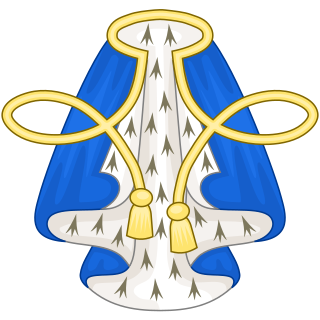
Bluemantle Pursuivant of Arms in Ordinary is a junior officer of arms of the College of Arms in London. The office is reputed to have been created by King Henry V to serve the Order of the Garter, but there is no documentary evidence of this. There is, however, mention of an officer styled Blewmantle going to France in 1448. The first Bluemantle to be mentioned by name is found in a record from around 1484. The badge of office, probably derived from the original blue material of the Order of the Garter, is blazoned as A Blue Mantle lined Ermine cords and tassels Or.

Rouge Dragon Pursuivant of Arms in Ordinary is a junior officer of arms of the College of Arms, instituted by Henry VII on 29 October 1485, the eve of his coronation, in reference to the royal badge, the red dragon of Cadwaladr.

Arundel Herald of Arms Extraordinary is a supernumerary Officer of Arms in England. Though a royal herald, Arundel is not a member of the College of Arms, and was originally a private herald in the household of Thomas Fitzalan, Earl of Arundel. The first herald, John Cosoun, is known to have served the Earl both in Portugal in 1413 and later in France, where he attended his dying master in October 1415. The title was revived in 1727 as Herald Extraordinary.
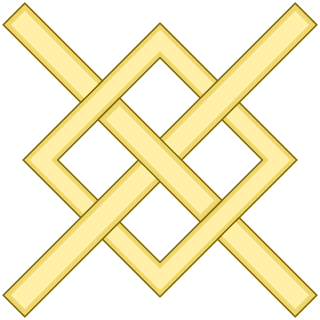
Maltravers Herald of Arms Extraordinary is a current officer of arms extraordinary in England. As such, Maltravers is a royal herald, but is not a member of the College of Arms in London. The present office was created in 1887 by the Earl Marshal, who was also the Duke of Norfolk and Baron Maltravers. The office is known to have been held by a pursuivant to Lord Maltravers when he was deputy of Calais from 1540 to 1544. The badge is blazoned as A Fret Or. It was officially assigned in 1973, though it had been assumed by two Maltravers Heralds in the 1930s. It derives from the coat of arms of Maltravers Sable a Fret Or and a Label of the points Ermine, and was the badge of John, Earl of Arundel through which family the barony passed to the Howard dukes of Norfolk.

Wales Herald of Arms Extraordinary is a current Officer of Arms Extraordinary under the Courts of England and Wales' jurisdiction. Wales is a Royal Herald, ie a member of the Royal Household, and while not being a member of chapter of the College of Arms, processes with the other heralds at ceremonial occasions. Wales Herald forms an integral part of the procession when the British monarch officially opens a session of Senedd Cymru at Cardiff Bay.

Norfolk Herald of Arms Extraordinary is an officer of arms in England. As an officer extraordinary, Norfolk is a royal herald, though not a member of the corporation of the College of Arms in London. Beginning in 1539 this officer was a herald to the dukes of Norfolk, though the first holder, John James, was paid a salary by King Henry VIII. Subsequent Norfolk heralds have been officers extraordinary, though the office has not always been filled but rather revived when required. The badge of office, assigned in 1958, is blazoned as Two Ostrich Feathers saltirewise each charged with a Gold Chain laid along the quill. It derives from the ostrich feather badge granted by King Richard II around 1387 as a mark of special favor to Thomas Mowbray, Duke of Norfolk, Marshal of England. Mowbray was also the first to be styled Earl Marshal.

Portcullis Pursuivant of Arms in Ordinary is a junior officer of arms at the College of Arms in London. The office is named after the Portcullis chained Or badge of the Beauforts, which was a favourite device of King Henry VII. King Henry's mother was Lady Margaret Beaufort. The office was instituted around 1485, probably at the time of Henry's coronation. The badge of office is very similar to that of Somerset Herald of Arms in Ordinary, the latter being ensigned with the Royal Crown. The earliest recorded Portcullis Pursuivant was James or Jacques Videt, who was the plaintiff in a Common Pleas case in 1498 and again in 1500.
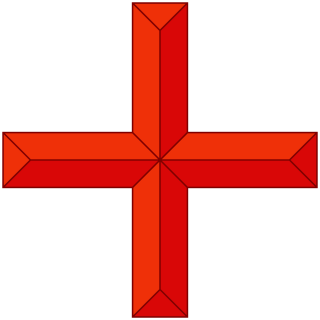
Rouge Croix Pursuivant of Arms in Ordinary is a junior officer of arms of the College of Arms. He is said to be the oldest of the four pursuivants in ordinary. The office is named after St George's Cross which has been a symbol of England since the time of the Crusades.
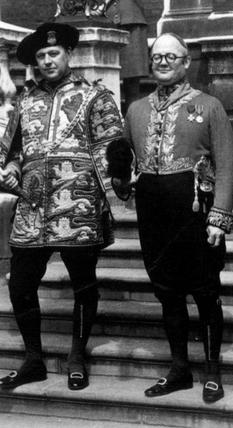
Sir Alexander Colin ColeFRHSC (Hon) was a long serving officer of arms at the College of Arms in London. Eventually, he would rise to the rank of Garter Principal King of Arms, the highest heraldic office in England.
Charles WilfridScott-Giles was an English writer on heraldry and an officer of arms, who served as Fitzalan Pursuivant Extraordinary.

Surrey Herald of Arms Extraordinary was an English officer of arms. Though an officer of the crown, Surrey Herald Extraordinary was not a member of the corporation of the College of Arms in London. This office was created in 1856 and first held by Edward Stephen Dendy. The badge of office was assigned in 1981. The badge is blazoned Within a representation of a Herald's Collar of SS Argent a Tabard chequy Or and Azure. These were the arms of John de Warenne, Earl of Surrey in the late thirteenth century, from whom the earldom descended through the Fitzalans to the Howard dukes of Norfolk and earls marshal.
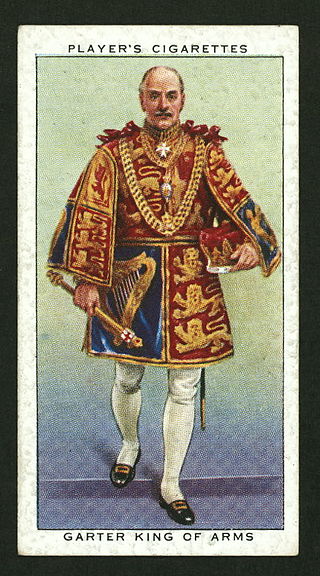
Sir Gerald Woods Wollaston was a long-serving officer of arms at the College of Arms in London. Wollaston's family had a firm tradition at the College of Arms. Wollaston's great-grandfather was Sir William Woods, Garter Principal King of Arms from 1838 until his death in 1842. His grandfather was Sir Albert William Woods who held the same post from 1869 to 1904.

Sir Algar Henry Stafford Howard was a senior British Army officer and long-serving officer of arms at the College of Arms in London. He served as the Garter Principal King of Arms from 1944 to 1950 before retiring. He was the third consecutive Fitzalan Pursuivant of Arms Extraordinary to attain the highest rank at the College of Arms.
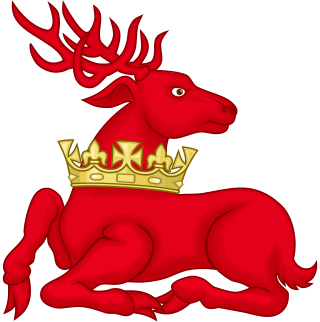
Falkland Pursuivant of Arms is a Scottish pursuivant of arms of the Court of the Lord Lyon.
Blanche Lyon Pursuivant of Arms in Ordinary was an English office of arms created during the reign of King Edward IV.

Howard Pursuivant of Arms Extraordinary was an officer of arms extraordinary in England; that is, a royal herald but not a member of the College of Arms in London.



























